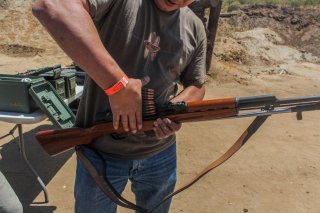Russian Civilians Are Beginning to Really Love Guns
A single bullet provides an interesting loophole.
Here’s What You Need to Remember: While not the strictest in the world, Russian gun laws are notorious among Russian gun owners for their five-year waiting period. While a regular gun license is moderately easy to acquire for a law-abiding citizen with a good record of mental health, this license only allows a citizen to own smoothbore firearms—generally shotguns of various types. While shotguns are generally useful outdoors guns for most hunting and animal self-defense tasks, they are less than ideal for longer-range hunting or target shooting. But Russian gun owners are only allowed to buy rifles after owning smoothbore guns for five years.
As a result, the Russian cartridge manufacturer “Техкрим” (Techkrim) created the .366 TKM (TKM being an abbreviation of TechKriM) cartridge around 2015. Technically, the .366 TKM is a smoothbore cartridge, as firearms chambered in it are smooth for the majority of the bore. However, the last 140mm or so of a barrel will be rifled, resulting in a barrel that’s “paradox rifled.” As these are still technically smoothbore weapons under Russian law, weapons in .366 TKM are legal to own without the five year waiting period.
The .366 TKM is also designed to be very close to the military 7,62x39mm caliber, allowing for guns to be easily adapted to .366 TKM. The angle of the cartridge walls are identical to 7,62x39, but the cartridge neck is deleted to accommodate the larger .366 caliber bullet, and likely to give it credence as a proper “smoothbore” round. 7,62x39 guns are easily rechambered to .366 TKM by boring out the barrel and chamber—an important feature in Russia where surplus military stocks can be “civilianized” and sold to the public.
As a result, most popular 7,62x39 firearm designs have versions in .366 TKM. AKs, RPKs, SKSs have all been produced in .366 TKM chamberings, primarily by the “Molot” weapons plant. .366 TKM weapons have been very popular, showing up on most Russian shooting channels as affordable and available alternatives to proper rifles. While not as accurate or long-ranged as proper 7,62x39 firearms, they are “good enough” at shorter ranges, and give rifle-like ergonomics and performance to those who would only be able to own shotguns before.
The success of .366 TKM led Techkrim and Molot to collaborate again on a larger version of .366 TKM called the 9,6x53mm Lancaster in 2017. Due to potential legal issues with paradox rifled guns due to shifting gun laws in Russia, Techkrim and Molot decided to make 9,6x53mm use Lancaster rifling, which relies on an oval-shaped smooth bore to impart spin on the bullet, which also is oval-shaped. As this is a different approach from the lands and grooves paradox rifling, it allows both companies to diversify their product line in the event of a potential paradox rifle ban.
9,6x53mm Lancaster is a similarly civilianized version of the 7,62x54Rmm round, even retaining the rim of the old military cartridge. One of Molot’s more popular rifles is a version of the AK adapted to the 7,62x54R cartridge, as it’s cheaper and simpler to manufacture than the military SVD. Those rifles were adapted to the 9,6x53mm caliber on its release, to provide Russian shooters with a proper “full size” rifle capable of taking larger game.
While not particularly relevant to the global market, as most countries don’t restrict the purchase of rifles if a citizen is properly qualified, the .366 TKM and 9,3x53mm cartridges illustrate the adaptability of the Russian civilian firearms manufacturers. Russian gun culture is on the rise, and manufacturers are stepping up to meet that demand.
Charlie Gao studied political and computer science at Grinnell College and is a frequent commentator on defense and national security issues.
Image: Flickr.
This article was first published in 2020.

